
Coffee drinks are made by brewing water with ground coffee beans. The brewing is either done slowly, by drip, filter, French press, moka pot or percolator, or done very quickly, under pressure, by an espresso machine. When put under the pressure of an espresso machine, the coffee is termed espresso, while slow-brewed coffees are generally termed brewed coffee. While all coffee drinks are based on either coffee or espresso, some drinks add milk or cream, some are made with steamed milk or non-dairy milks, or add water (like the americano). Upon milk additions, coffee's flavor can vary with different syrups or sweeteners, alcoholic liqueurs, and even combinations of coffee with espresso or tea.[1] There are many variations to the basic coffee or espresso bases.
With the invention of the Gaggia machine, espresso and espresso with milk, such as cappuccino and latte, spread in popularity from Italy to the UK in the 1950s. It then came to America, and with the rise in popularity of the Italian coffee culture in the 1980s, it began to spread worldwide via coffeehouses and coffeehouse chains.[2][3]
The caffeine content in coffee beans may be reduced via one of several decaffeination processes to produce decaffeinated coffee, also known as decaf, which may be served as regular, espresso or instant coffee.
Drip-brewed, or filtered coffee, is brewed by hot water passing slowly over roasted, ground coffee beans contained in a filter. Water seeps through the ground coffee, absorbing its oils, flavours and essences as it passes through the filter. The used coffee grounds remain in the filter as the liquid slowly drips into a collecting vessel, such as a carafe or pot.
Paper coffee filters were invented in Germany by Melitta Bentz in 1908.[4] To reduce waste, some coffee drinkers use fine wire mesh filters, which can be re-used for years. Many countries in Latin America and Africa, traditionally, prepare drip coffee using a small reusable bag made of cotton or other cloth.
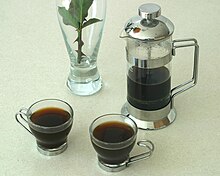
A French press, also known as a press pot, coffee press, coffee plunger, cafetière (UK) or cafetière à piston, is a coffee brewing device patented by Italian designer Attilio Calimani in 1929.[5] A French press requires a coarser grind of coffee than a drip brew coffee filter, as finer grounds will seep through the press filter and into the coffee.[6]
Coffee in a French press is brewed by placing the ground coffee in the empty beaker and adding hot (93–96 °C, 200–205 °F) water, in proportions of about 28 grams (1 ounce) of coffee to 450 millilitres (15 US fluid ounces; 16 imperial fluid ounces) of water, more or less to taste. After approximately four minutes the plunger is pressed to separate the grounds and hold them at the bottom of the beaker, then the coffee is poured.[7] Coffee press users have different preferences for how long to wait before pressing the plunger, with some enthusiasts preferring to wait longer than four minutes.
Cold brew coffee, also called cold water extraction or cold pressing, is the process of steeping coffee grounds in water at cool temperatures for an extended period. Coarse-ground beans are soaked in water for about 12 to 24 hours.[8][9]

Flash brewing is another Japanese style of cold coffee brewing. It is similar to drip coffee, as it involves pouring hot water over ground coffee contained in a filter. In this method, a smaller amount of hot water is used and the coffee is dripped directly over ice which immediately cools the coffee down. Unlike cold brewing – another cold coffee method – flash brewed coffee preserves the flavor and acidity that is characteristic of hot drip coffee. Because of this, flash brew coffee is well suited for lighter roasts of coffee, chosen for their unique and complex flavors.[10] In many coffeeshops and coffee chains, iced coffee is made by taking hot coffee and adding ice, which waters down the coffee over time. Flash brewing works around this issue.
A coffee percolator is a type of pot used to brew coffee by continually cycling the boiling water through the grounds using gravity until the required coffee strength is reached. There are stove-top percolators and standalone units which contain a built-in heating element. Percolators were popular until the 1970s, when they were widely replaced with other techniques. By the mid-1970s, many companies ceased production of percolators.[citation needed]

Beans for Turkish coffee are ground to a fine powder. Turkish coffee is prepared by immersing the coffee grounds in water and heating until it just boils. This method produces the maximum amount of foam. If the coffee is left to boil longer, less foam remains. In Turkey, four degrees of sweetness are used. The Turkish terms and approximate amounts are as follows: sade (plain; no sugar), az şekerli (little sugar; half a level teaspoon of sugar), orta şekerli (medium sugar; one level teaspoon), şekerli or çok şekerli (high sugar; two or three teaspoons). Before boiling, the coffee and the desired amount of sugar are stirred until all the coffee sinks and the sugar is dissolved. If the coffee is stirred for longer (up to the boiling point), little or no foam remains. The Turkish term for this kind of coffee is köpüksüz (no foam).
Turkish coffee is an Intangible Cultural Heritage of Turkey confirmed by UNESCO.[11]
|
Not to be confused with Caffè mocha. |

Moka coffee is coffee brewed with a moka pot, a stovetop coffee maker which produces coffee by passing hot water pressurized by steam through ground coffee at a lower pressure than an espresso maker. The moka pot is an Italian invention, first produced by Bialetti in the early 1930s. The flavor of moka coffee depends greatly on bean variety, roast level, fineness of grind, and the level of heat used. Due to the higher-than-atmospheric pressure involved, the mixture of water and steam reaches temperatures well above 100 °C (212 °F), causing a more efficient extraction of caffeine and flavors from the grounds, and resulting in a stronger brew than that obtained by drip brewing.[citation needed]
Kopi kothok is made by boiling coffee grounds and sugar together in a pot or a saucepan. It is very common in Cepu and Bojonegoro.[12] The ratio of coffee grounds and sugar is generally one to two. A 1:1 ratio for more bitter coffee drinks.[13] Milk also can be added according to the order before boiling the coffee grounds.
A vacuum coffee maker brews coffee using two chambers where vapor pressure and vacuum produce coffee. This type of coffee maker is also known as vac pot, siphon or syphon coffee maker, and was invented by Loeff of Berlin in the 1830s. These devices have since been used for more than a century in many parts of the world and more recently have been given a new use by bartenders and chefs to make hot cocktails and broths.[14]
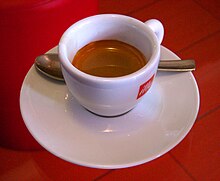
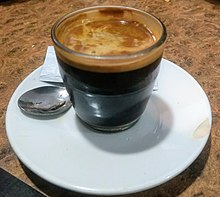

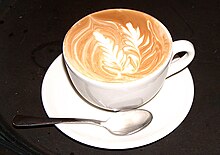
Espresso is brewed by machine, forcing a small amount of nearly boiling water and steam – about 86 to 95 °C (187 to 203 °F) – under pressure through finely ground and compacted coffee.[15][16] The espresso machine was patented in 1901 from an earlier 1884 machine,[17][18] and developed in Italy; with the invention of the Gaggia machine, espresso spread in popularity to the UK in the 1950s where it was more often drunk with milk as cappuccino due to the influence of the British milk bars,[19][20][3] then America in the 1980s where again it was mainly drunk with milk,[3] and then via coffeehouse chains it spread worldwide.[3] Espresso is generally denser than coffee brewed by other methods, having a higher concentration of suspended and dissolved solids; it generally has a creamy foam on top known as crema.[21] Espresso is the base for a number of other coffee drinks, such as latte, cappuccino, macchiato, mocha, and americano.[22]
Cortado is a Spanish beverage made by pouring a small amount of espresso in a small glass cup, then cutting it with an equal amount of steamed milk in order to neutralize the bitterness. The name comes from the Spanish word cortar, meaning to cut, which refers to the preparation process.
The ratio of espresso to milk gives a unique flavor where the robustness of the coffee comes through, while the finish is velvety due to steamed milk. Cortado is typically consumed in coffee bars as it is not intended to be taken on the go.
A flat white is an espresso with microfoam (steamed milk with small, fine bubbles and a glossy or velvety consistency). It is comparable to a latte, but smaller in volume and with less microfoam, therefore having a higher proportion of coffee to milk, and milk that is more velvety in consistency – allowing the espresso to dominate the flavour, while being supported by the milk.
Cuban tradition is to drink coffee strong and sweet, often mixing the sugar with the coffee beans before brewing. The traditional method of brewing coffee was a filter method using a cloth cone; this has mostly been replaced with an aluminium cafetera or coffeemaker—in tourist areas some cafés will have an espresso machine, though espresso machines are expensive, so espresso is not a common drink for most Cubans.[24][25] Though quality coffee is grown in Cuba, it is expensive, so most Cubans drink coffee imported from Puerto Rico, and often mixed with ground peas.[26][27] The Cuban habit of brewing coffee with sugar has spread to Miami, West Palm Beach, Tampa and the Keys, in Florida, where espresso is the preferred brewing method and an espresso brewed with sugar is termed café cubano, Cuban coffee, Cuban espresso, cafecito, Cuban pull, or Cuban shot.[28] Sometimes demerara sugar is used, and sometimes the sugar (white or brown) is not brewed with the coffee, but is placed in the cup as the coffee is dripped into it, then stirred into a froth.[29][30] Variations on the Miami café cubano are with a splash of milk – cortadito; and with steamed milk – café con leche.[31]
Caffè crema (Italian: cream coffee) refers to two different coffee drinks:[32] an old name for espresso (the 1940s and 1950s), and a long espresso drink primarily served in Germany, Switzerland and Austria and northern Italy (the 1980s onwards), along the Italian/ Swiss and Italian/ Austrian border.[33] As a term, it generally means "espresso", while in technical discussions, referring to the long drink, it may more narrowly be referred to as Swiss caffè crema. Variant terms include "crema caffè" and the hyperforeignism "café crema" – "café" is French, while "caffè" and "crema" are Italian, thus "café crema" mixes French and Italian.
|
Main article: Milk coffee |
Café bombón was made popular in Valencia, Spain, and spread gradually to the rest of the country. It might have been re-created and modified to suit European tastebuds as in many parts of Asia such as Malaysia, Thailand, Vietnam and Singapore. The same recipe for coffee which is called Kopi Susu Panas (Malaysia), or Gafeh Rorn [lit: hot coffee] (Thailand) has already been around for decades and is very popular in mamak stalls and kopitiams in Malaysia. The iced version is known as cà phê đá in Vietnam. A café bombón, however, uses espresso served with sweetened condensed milk in a 1:1 ratio whereas the Asian version uses ground coffee and sweetened condensed milk at different ratios. On the Canary Islands a variety named café proprio or largo condensada is served using the same amount of condensed milk but with "café largo" or espresso lungo. For café bombón, the condensed milk is added to the espresso. For visual effect, a glass is used, and the condensed milk is added slowly to sink underneath the coffee and create two separate bands of contrasting colour – though these layers are customarily stirred together before consumption. Some establishments merely serve an espresso with a sachet of condensed milk for patrons to make themselves.[citation needed]
There is a coffee drink combined with coconut milk from Blora, Indonesia. It is called kopi santen (Javanese) or kopi santan (Indonesian). Formulated for the first time in 1980 by a grandmother named Sakijah.[37]
Regular coffee (slow brewed as with a filter or cafetière) is sometimes combined with espresso to increase either the intensity of the flavour or the caffeine content.[38] This may be called a variety of names, most commonly red eye,[39] or shot in the dark.[40][41] Coffeehouse chains may have their own names, such as turbo at Dunkin' Donuts.[42] and depth charge – a federally registered trademark of Caribou Coffee.[43] At Starbucks, a double shot of espresso in the coffee may be termed a "black eye", and a triple shot a "dead eye". "Caffè Tobio" is a version with an equal amount of coffee to espresso.[44]

|
Main article: Liqueur coffee |
|
Main category: Alcoholic coffee drinks |
|
Not to be confused with Coffee liqueurs. |
A liqueur coffee is a coffee brew with a 25-milliliter (0.85 U.S. fl oz; 0.88 imp fl oz) shot of liqueur. This brew is usually served in a clear liqueur coffee glass with the coffee and cream separated for visual and taste effect. The liqueur of choice is added first with a teaspoon of sugar mixed in. The glass is then filled to within 2.5 cm (1 inch) of the top with filtered coffee. Slightly whipped cream may then be poured over the back of a spoon, so that it floats on top of the coffee and liqueur mixture. The sugar is required in the coffee mixture to help the cream float.[citation needed]
The caffeine content of these drinks, to the extent that caffeine is present in them, will not prevent intoxication from their alcohol content. Instead, the caffeine may mask the true degree of ethanol-induced loss of coordination.
Some coffeehouses provide flavoured syrups which customers can have added to their coffee drinks. Some non-dairy creamers have flavoured versions, such as hazelnut flavour and Irish Cream flavour (the latter is non-alcoholic). Other flavored coffees are named, and offered at coffee houses either globally or regionally.
A cafe con miel or café miel has a shot of espresso, steamed milk, cinnamon, and honey. The name comes from the Spanish word for honey, miel.[46]
Café de olla or pot coffee is a traditional coffee-based drink prepared using earthen clay pots or jars in Mexico and other Latin American countries. It is flavored with cinnamon and piloncillo. Consumed primarily in colder weathers, usually with the merienda meal, and accompanied with pan dulce pastries.[47]
The marocchino is made from espresso, steamed milk, and a dusting of cocoa powder, similar to the espressino.[48][49]
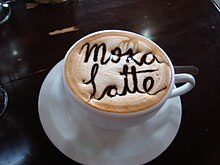
A café mocha is a variant of a caffè latte. Like a latte, it is typically one third espresso and two thirds steamed milk, but a portion of chocolate is added, typically in the form of a chocolate syrup, although other vending systems use instant chocolate powder. Mochas can contain dark or milk chocolate.[50]
The term moccaccino is used in some regions of Europe and the Middle East to describe caffè latte with cocoa or chocolate. In the U.S. it usually refers to a cappuccino made with chocolate.[51]
A cafe borgia is a mocha with orange rind and sometimes orange flavoring added. Often served with whipped cream and topped with cinnamon.[52]
A café rápido y sucio, or a quick & dirty coffee, is three shots of espresso topped with chocolate or mocha syrup. Unlike a café mocha which has milk added or an Americano which has water added, a Café Rápido y Sucio or a Quick & Dirty Coffee is espresso and chocolate only. Any variation of this drink containing more than three shots of espresso would be referred to as a Fast & Filthy Coffee.[53]
Melya is coffee flavoured with cocoa powder and honey.[54] Cream is sometimes added.[54]
A mint coffee that originated from the city of Padua in the Caffè Pedrocchi. It is indeed known in Padua as Pedrocchi; while in the rest of Italy as Caffè Padovano,[55] which can be translated as Paduan Coffee. It is made of a lower layer of hot espresso coffee, a middle thick layer of fresh cream and mint syrup, and an upper thin layer of cocoa powder.[56][57] The beverage is not to be stirred nor added with sugar.
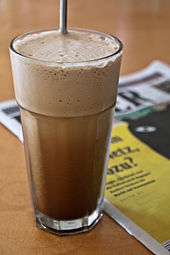
Greek frappé (Café frappé) (Greek: φραπές), sometimes called a javaccino[58][59][60] by independent coffeehouses, is a foam-covered iced coffee drink made from spray-dried instant coffee. It is very popular in Greece especially during summer but has now spread on to other countries.
There are numerous ways in which this coffee can be tailored to the individual's taste, such as: all water-no milk; half-half; all milk and; varying levels of sweetness. Frappe is also extremely popular in Cyprus where fresh milk is used as opposed to condensed. In French, when describing a drink, the word frappé means shaken or chilled; however, in popular Greek culture, the word frappé is predominantly taken to refer to the shaking associated with the preparation of a café frappé.[citation needed]
Freddo espresso is a foam-topped iced coffee made from espresso that is commonplace in Greece. It consists of two shots of espresso (30–50 ml [1.1–1.8 imp fl oz; 1.0–1.7 US fl oz]), sugar (granules or syrup), and ice (60–100 ml [2.1–3.5 imp fl oz; 2.0–3.4 US fl oz]) 1:2 (espresso shots:ice). The espresso is mixed with the sugar and ice in a frapièra (a drink mixer), which cools the espresso and produces a foam from the oils of the coffee. This mixture is then poured over ice into a serving glass.
Freddo cappuccino is another variation of the original cappuccino and is as popular as the freddo espresso. It follows the same process as the freddo espresso but is topped with a cold milk froth called afrógala (Greek: αφρόγαλα) which is added in ratio 1:2 (espresso shots:milk), and 1:2 (espresso shots:ice). The choice of milk used to create the afrógala may vary from fresh to condensed. Recently the Coffee Island coffee shop (a coffee shop franchise in Greece), established a new foam and cream trend in freddo cappuccino. They use plant-based milk creamed in the frapièra. The result is a stiffer and sweeter cream.
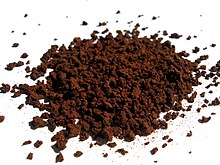
Instant coffee is a drink derived from brewed coffee beans. Through various manufacturing processes the coffee is dehydrated into the form of powder or granules. These can be rehydrated with hot water to provide a drink similar (though not identical) to conventional coffee. At least one brand of instant coffee, Camp Coffee, is also available in concentrated liquid form.
Instant coffee is used as an ingredient in other coffee drinks. Indian beaten coffee is made from instant coffee whipped with sugar and served over warm milk. A Korean drink known as dalgona coffee is prepared similarly but can be served hot or cold. A Greek frappé coffee is made again from instant coffee, sugar, and milk, but it is prepared in a cocktail shaker.
Instant coffee brands include:
A decaffeination process removes caffeine from coffee beans to lower their caffeine content.[61] Four main methods are used to extract caffeine from coffee beans:
Decaffeinated coffee grew in popularity over the last half of the 20th century, mainly due to health concerns that arose regarding the over-consumption of caffeine.[63][64][65] Decaffeinated coffee, sometimes known as "decaf", may be drunk as regular brewed coffee, instant, espresso, or as a mix of regular caffeine beans and decaffeinated beans.[66][67] Ludwig Roselius, a German coffee merchant and founder of the company Kaffee HAG, is credited with the development of commercial decaffeination of coffee.[68]

An affogato (Italian for "drowned") is vanilla gelato with hot espresso poured over it.[69] Affogato style, which refers to the act of topping a drink or dessert with espresso, may also incorporate caramel sauce or chocolate sauce. When ordered, an affogato tends to be served with scoops of ice cream with a shot (or 2) of espresso poured over the top, sometimes mixed with a liqueur. A white affogato is the same as a regular affogato, just with milk added.[citation needed]
A babyccino is frothed up milk and warm milk in an espresso cup prepared for young children, a cappuccino for babies. The split should be about 80% foam and 20% warm milk with a sprinkling of cacao powder on top. The foam should be oxygenated pillows of foam and the temperature of the milk should be about 40.5 °C (105 °F). This is so the natural sweetness of the milk can be best maintained. The drink originated in Sydney, Australia, in the late 1980s by the famed Zigolini's coffee house.
A caffè Medici is a doppio poured over chocolate syrup and orange peel, usually topped with whipped cream. The drink originated at Seattle's historic Last Exit on Brooklyn coffeehouse.[70]
Café Touba is the spiritual drink of Senegal, named after Cheik Ahmadou Bamba Mbacké (known as Serigne Touba) and the holy city of Touba in Senegal.[71] During the roasting process, the coffee beans are mixed with grains of selim, and sometimes other spices, and ground into powder after roasting.[71] The drink is prepared using a filter, similar to plain coffee. Sugar is often added before drinking.[71]
Canned coffee is ubiquitous in Japan and throughout East Asia, with a large number of companies competing fiercely and offering various types for sale. Canned coffee is already brewed and ready to drink. It is available in supermarkets and convenience stores,[72] with vast numbers of cans being sold in vending machines[73] that offer heated cans in the autumn and winter,[74] and cold cans in the warm months.
Some brands in the United States have recently begun selling similar products in gas stations, grocery stores, and corner stores, though it is not nearly as widespread as the Japanese version is in Japan.[75][76] Brands of canned coffee include these:
Coffee beer is a drink from Jombang, Indonesia. The composition of coffee beer is coffee, sugar, water, caramel, and soda. Usually, the drink is served in a glass filled with ice cubes to add freshness to the drink. It contains no alcohol.[77]

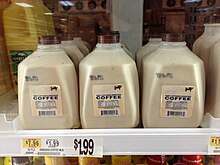

Coffee milk is sold in two ways: prepared coffee milk and coffee syrup. It is a drink prepared or made by adding a sweetened coffee concentrate called coffee syrup to milk in a manner similar to chocolate milk. It is the official drink of Rhode Island in the United States.[78] Coffee milk brands include:
It is popular in South Australia where it is known as iced coffee but that should not be confused with the drink of the same name made from coffee with ice but without milk or with little milk that is popular in the United States and other countries.
Double-double or Double Double is a uniquely Canadian term that is also a registered trademark of Tim Hortons.[79] This menu item consists of a cup of drip coffee with two creams and two sugars (or double cream, double sugar). The chain achieves flavor consistency across cup sizes by employing a pair of countertop vending machines, one dispensing cream and milk and the other dispensing white granulated sugar, with buttons for different cup sizes and amounts. The coffee is always poured over the cream and sugar to achieve the correct volume of ingredients. The drink can be made with cream or milk. Additional terms include the menu item "Regular" (one shot of each); a "triple-triple" (three shots of each); a "four-by-four" (four shots of each);[80] and a "Wayne Gretzky" (nine shots of each). A "Wayne Gretzky" is more of a legend or joke than a feasible order; for comparison, a medium Regular has 6g fat and 11g sugar[81] (approximately 3 tsp of cream and 2 1/2 tsp white sugar), so a Wayne Gretzky in a medium size would have nine times that amount: 54g fat and 99g of sugar, approximately 1/2 cup cream (27 teaspoons, or 118ml, or 4oz) and 2/5 cups of sugar (22 1/2 teaspoons). A medium cup is approximately 14oz (414ml),[82] and would consist almost entirely of the cream and sugar.
Egg coffee (Vietnamese: Cà phê trứng) is a Vietnamese drink from Hanoi with thick texture traditionally prepared with egg yolks, sugar, condensed milk and drip coffee.
South Indian coffee, also known as Madras filter coffee, Kumbakonam degree coffee, Mylapore filter coffee, Mysore filter coffee, Palakkad Iyer coffee or South Indian Filter Coffee (Kaapi) or kaapi (South Indian phonetic rendering of "coffee") is a sweet milky coffee made from dark roasted coffee beans (70–80%) and chicory (20–30%), especially popular in the southern states of Andhra Pradesh, Karnataka, Kerala and Tamil Nadu. The most commonly used coffee beans are Koffeey Arabica (Coffee Arabica grown from Arehalli Village) Peaberry (preferred), Arabica, Malabar and Robusta grown in the hills of Karnataka (Kodagu, Chikkamagaluru), Kerala (Malabar region) and Tamil Nadu (Nilgiris District, Yercaud and Kodaikanal).[citation needed]
A shot or small portion of unsweetened coffee, now usually made either using an espresso machine or a moka pot, but traditionally made using a cloth drip, usually served in cups made for the purpose, called "tacitas de pocillo". It is widely drunk in Latin America, usually as an afternoon or after-dinner coffee. The defining feature is the size, usually half to a quarter the size of the usual ~240-milliliter (8 U.S. fl oz; 8.3 imp fl oz) coffee cups. There are a number of small-sized drinks that use tacitas de pocillo, including such sweetened varieties as café cubano and café cortado, but these are usually not called a pocillo; rather, the Spanish diminutive suffix "-ito" is usually added to the name of the drink wanted in a pocillo size cup. For example, a pocillo-sized cortado is usually called a cortadito.[citation needed]